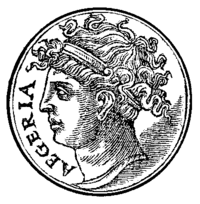- Camenae
-
Topics in Roman mythology Important Gods: Roman Kingdom Religion in ancient Rome Flamens Roman, Greek, and Etruscan mythologies compared — Other Rustic Gods:  A 16th-century drawing of Egeria by Guillaume Rouille
A 16th-century drawing of Egeria by Guillaume Rouille
In Roman mythology, the Camenae (also Casmenae, Camoenae) were originally goddesses of childbirth, wells and fountains, and also prophetic deities.
There were four Camenae:
The latter two were sometimes specifically referred to as the Carmentae, and in ancient times might have been two aspects of Carmenta rather than separate figures; in later times, however, they are distinct beings believed to protect women in labour.
Carmenta or Carmentis was the chief among the nymphs. The spring and grove outside the Porta Capena was dedicated to Egeria. On her festival day, the Carmentalia, which fell on January the 11 and 15, Vestal Virgins drew water from that spring for the rites.
The Camenae were later identified with the Greek Muses; in his translation of Homer's Odyssey, Livius Andronicus rendered the Greek word Mousa as Camena.
See also
External links
Time in religion and mythology Time and fate deities · Eternity · Eschatology · Golden Age · Divination · Prophecy · Fate · Calendar
This article relating to an Ancient Roman myth or legend is a stub. You can help Wikipedia by expanding it.
